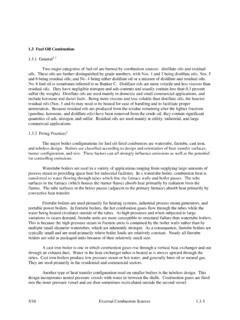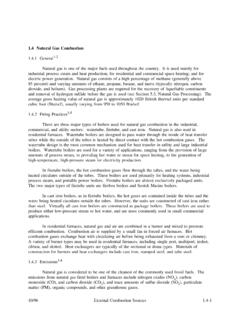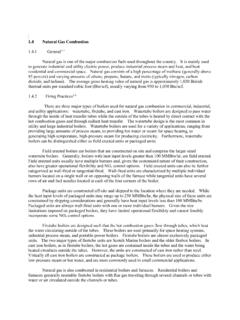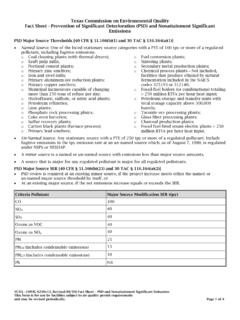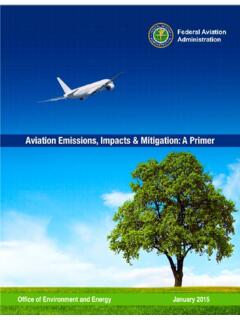Transcription of METHOD 201A DETERMINATION OF PM10 AND PM2.5 …
1 METHOD 201A 8/2/2017 1 While we have taken steps to ensure the accuracy of this Internet version of the document, it is not the official version. The most recent edits to this METHOD were published here: To see a complete version including any recent edits, visit: and search under Title 40, Protection of Environment. METHOD 201A DETERMINATION OF PM10 AND EMISSIONS FROM STATIONARY SOURCES (CONSTANT SAMPLING RATE PROCEDURE) Scope and Applicability Scope. The Environmental Protection Agency ( EPA or we ) developed this METHOD to describe the procedures that the stack tester ( you ) must follow to measure filterable particulate matter (PM) emissions equal to or less than a nominal aerodynamic diameter of 10 micrometers (PM10) and micrometers ( ). This METHOD can be used to measure coarse particles ( , the difference between the measured PM10 concentration and the measured concentration).
2 Applicability. This METHOD addresses the equipment, preparation, and analysis necessary to measure filterable PM. You can use this METHOD to measure filterable PM from stationary sources only. Filterable PM is collected in stack with this METHOD ( , the METHOD measures materials that are solid or liquid at stack conditions). If the gas filtration temperature exceeds 30 C (85 F), then you may use the procedures in this METHOD to measure only filterable PM (material that does not pass through a filter or a cyclone/filter combination). If the gas filtration temperature exceeds 30 C (85 F), and you must measure both the filterable and condensable (material that condenses after passing through a filter) components of total primary (direct) PM emissions to the atmosphere, then you must combine the procedures in this METHOD with the procedures in METHOD 202 of appendix M to this part for measuring condensable PM.
3 However, if the gas filtration temperature never exceeds 30 C (85 F), then use of METHOD 202 of appendix M to this part is not required to measure total primary PM. Responsibility. You are responsible for obtaining the equipment and supplies you will need to use this METHOD . You must also develop your own procedures for following this METHOD and any additional procedures to ensure accurate sampling and analytical measurements. Additional Methods. To obtain results, you must have a thorough knowledge of the following test methods found in appendices A-1 through A-3 of 40 CFR part 60: (a) METHOD 1 Sample and velocity traverses for stationary sources. (b) METHOD 2 DETERMINATION of stack gas velocity and volumetric flow rate (Type S pitot tube). (c) METHOD 3 Gas analysis for the DETERMINATION of dry molecular weight. (d) METHOD 4 DETERMINATION of moisture content in stack gases.
4 (e) METHOD 5 DETERMINATION of particulate matter emissions from stationary sources. METHOD 201A 8/2/2017 2 Limitations. You cannot use this METHOD to measure emissions in which water droplets are present because the size separation of the water droplets may not be representative of the dry particle size released into the air. To measure filterable PM10 and in emissions where water droplets are known to exist, we recommend that you use METHOD 5 of appendix A-3 to part 60. Because of the temperature limit of the O-rings used in this sampling train, you must follow the procedures in Section to test emissions from stack gas temperatures exceeding 205 C (400 F). Conditions. You can use this METHOD to obtain particle sizing at 10 micrometers and or micrometers if you sample within 80 and 120 percent of isokinetic flow. You can also use this METHOD to obtain total filterable particulate if you sample within 90 to 110 percent of isokinetic flow, the number of sampling points is the same as required by METHOD 5 of appendix A-3 to part 60 or METHOD 17 of appendix A-6 to part 60, and the filter temperature is within an acceptable range for these methods.
5 For METHOD 5, the acceptable range for the filter temperature is generally 120 C (248 F) unless a higher or lower temperature is specified. The acceptable range varies depending on the source, control technology and applicable rule or permit condition. To satisfy METHOD 5 criteria, you may need to remove the in-stack filter and use an out-of-stack filter and recover the PM in the probe between the particle sizer and the filter. In addition, to satisfy METHOD 5 and METHOD 17 criteria, you may need to sample from more than 12 traverse points. Be aware that this METHOD determines in-stack PM10 and filterable emissions by sampling from a recommended maximum of 12 sample points, at a constant flow rate through the train (the constant flow is necessary to maintain the size cuts of the cyclones), and with a filter that is at the stack temperature.
6 In contrast, METHOD 5 or METHOD 17 trains are operated isokinetically with varying flow rates through the train. METHOD 5 and METHOD 17 require sampling from as many as 24 sample points. METHOD 5 uses an out-of-stack filter that is maintained at a constant temperature of 120 C (248 F). Further, to use this METHOD in place of METHOD 5 or METHOD 17, you must extend the sampling time so that you collect the minimum mass necessary for weighing each portion of this sampling train. Also, if you are using this METHOD as an alternative to a test METHOD specified in a regulatory requirement ( , a requirement to conduct a compliance or performance test), then you must receive approval from the authority that established the regulatory requirement before you conduct the test. Summary of METHOD Summary. To measure PM10 and , extract a sample of gas at a predetermined constant flow rate through an in-stack sizing device.
7 The particle-sizing device separates particles with nominal aerodynamic diameters of 10 micrometers and micrometers. To minimize variations in the isokinetic sampling conditions, you must establish well-defined limits. After a sample is obtained, remove uncombined water from the particulate, then use gravimetric analysis to determine the particulate mass for each size fraction. The original METHOD , as promulgated in 1990, has been changed by adding a cyclone downstream of the PM10 cyclone. Both cyclones were developed and evaluated as part of a conventional five-stage cascade cyclone train. The addition of a cyclone between the PM10 cyclone and the stack temperature filter in the sampling train supplements the measurement of PM10 with the measurement of Without the addition of the cyclone, the filterable particulate portion of the sampling train may be used to measure total and PM10 emissions.
8 Likewise, with the exclusion of the PM10 METHOD 201A 8/2/2017 3 cyclone, the filterable particulate portion of the sampling train may be used to measure total and emissions. Figure 1 of Section 17 presents the schematic of the sampling train configured with this change. Definitions condensable particulate matter (CPM) means material that is vapor phase at stack conditions, but condenses and/or reacts upon cooling and dilution in the ambient air to form solid or liquid PM immediately after discharge from the stack. Note that all CPM is assumed to be in the size fraction. Constant weight means a difference of no more than mg or one percent of total weight less tare weight, whichever is greater, between two consecutive weighings, with no less than six hours of desiccation time between weighings. Filterable particulate matter (PM) means particles that are emitted directly by a source as a solid or liquid at stack or release conditions and captured on the filter of a stack test train.
9 Primary particulate matter (PM) (also known as direct PM) means particles that enter the atmosphere as a direct emission from a stack or an open source. Primary PM has two components: Filterable PM and condensable PM. These two PM components have no upper particle size limit. Primary (also known as direct , total , , or combined filterable and condensable PM) means PM with an aerodynamic diameter less than or equal to micrometers. These solid particles are emitted directly from an air emissions source or activity, or are the gaseous or vaporous emissions from an air emissions source or activity that condense to form PM at ambient temperatures. Direct emissions include elemental carbon, directly emitted organic carbon, directly emitted sulfate, directly emitted nitrate, and other inorganic particles (including but not limited to crustal material, metals, and sea salt).
10 Primary PM10 (also known as direct PM10, total PM10, PM10, or the combination of filterable PM10 and condensable PM) means PM with an aerodynamic diameter equal to or less than 10 micrometers. Interferences You cannot use this METHOD to measure emissions where water droplets are present because the size separation of the water droplets may not be representative of the dry particle size released into the air. Stacks with entrained moisture droplets may have water droplets larger than the cut sizes for the cyclones. These water droplets normally contain particles and dissolved solids that become PM10 and following evaporation of the water. Safety METHOD 201A 8/2/2017 4 Disclaimer. Because the performance of this METHOD may require the use of hazardous materials, operations, and equipment, you should develop a health and safety plan to ensure the safety of your employees who are on site conducting the particulate emission test.










